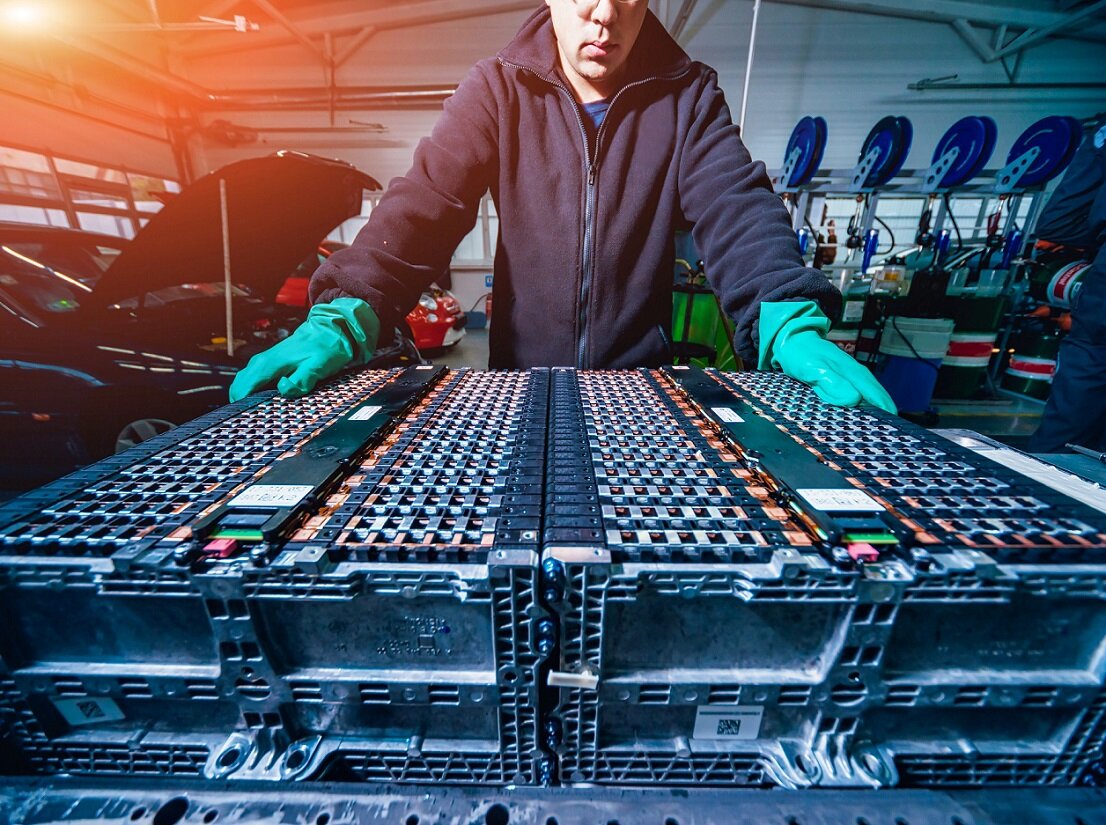Scientists at the Monash Energy Institute have developed a longer-lasting, lighter, and more ecologically responsible alternative to conventional lithium-ion batteries.
By employing a glucose-based additive on the positive electrode, the team has managed to stabilize lithium-sulfur battery technology, which has long been heralded as the foundation for the next generation of batteries.
These types of batteries would be ideal for use in electric vehicles, submarines, and aircraft. The team published their findings in the science journal Nature Communications.
Currently, most EV’s are powered with lithium-ion batteries containing scarce materials - Image Credit: Roman Zaiets via Shutterstock / HDR tune by Universal-Sci
What makes sulfur such a promising component for batteries?
The main issue with Lithium-Ion batteries is that rare-earth elements, nickel, and cobalt are needed to produce their positive electrodes. However, the reserve of these metals is limited. Industry insiders have even predicted severe shortages of these critical materials in the not-so-distant future. On top of that, mining them frequently comes with a high social and environmental cost.
Sulfur, on the other hand, is reasonably abundant and inexpensive. Miners generate about 70 million tonnes of sulfur each year, making it the 16th most plentiful element on the planet. If we want batteries to be widely utilized, this makes for an excellent component.
Finally, lithium-sulfur batteries rely on a different kind of chemical reaction that provides them with the capacity to store much more energy in comparison to lithium-ion batteries.
The problem with Lithium-sulfur batteries
As mentioned, Lithium-sulfur batteries should, in theory, be capable of storing up to five times as much energy as lithium-ion batteries do at the same weight. However, the main problem with Lithium-sulfur based batteries has been that the electrodes degraded very quickly in usage, after which the batteries fail.
There are two causes for this rapid degradation; first, the positive sulfur electrode is weakened by significant expansion and contraction, rendering it inaccessible to lithium. Secondly, negative lithium electrodes became polluted by sulfur compounds.
How sugar can be used to improve Lithium-sulfur batteries
The Monash researchers proved last year that they could expand the structure of the sulfur electrode to allow for expansion and make it more lithium accessible. In addition, they have now stabilized the sulfur by integrating sugar into the electrode's web-like design, preventing it from migrating and blanketing the lithium electrode.
Yingyi and her colleagues derived their inspiration from a 1988 geochemistry report that details how sugar-based materials resist degradations in geological sediments by creating strong bonds with sulfides.
The team's test-cell prototypes have demonstrated to be capable of surviving at least 1000 charge-discharge cycles while still maintaining a much larger capacity than lithium-ion batteries of the same weight. 1000 charge/discharge cycles would be more than enough for use in EV vehicles. Conservatively doubling the range of the average lithium-ion vehicle and charging it 1000 times would mean a lifespan of well above half a million kilometers.
The research team stabilized the sulfur by integrating sugar into the electrode's web-like design, preventing it from migrating and blanketing the lithium electrode. - (Image Credit: Monash Energy Institute)
According to Yingyi Huang, first author of the study, the new technology has two major benefits. Firstly, chargers last longer, extending the battery's life span, and secondly, producing the batteries doesn't require rare, dangerous, or expensive materials meaning that costs will probably be a lot lower.
Dr. Mahdokt Shaibani, the second author of the study, added that, although a lot of the cathode-related problems have been resolved by the research team, further research is required to find a way of protecting the lithium metal anode to allow large-scale uptake of this technology. However, Shaibani thinks the solution may be 'right around the corner.’
Future applications of Lithium-sulfur batteries
The researchers estimate that it would take less than a decade before we could see electric trucks and buses capable of taking on extensive trips of 900 kilometers (560 miles) or more without the need for a single charge.
In addition, the new battery technology could also be helpful for the further development of novel use cases, such as agricultural and delivery drones as weight is an essential factor for these types of unmanned aerial vehicles.
Increased energy density would mean improved range and lighter vehicles, making vehicle owners less dependent on charge stations during long road trips. - Image Credit: Universal-Sci (CC BY 4.0)
All in all, it seems that some optimism about these newly presented improvements to Lithium-sulfur battery technology is justified. If these ideas eventually come to fruition in real life, it would solve most of the remaining problems with current electric vehicles and open the road to new use cases such as electric aircraft.
As always, we will keep you updated on this topic.
Further reading:
A saccharide-based binder for efficient polysulfide regulations in Li-S batteries (Nature Communications)
Monash Energy Institute (Monash University)
Batteries made with sulfur could be cheaper, greener, and hold more energy! (Universal-Sci)
If you enjoy our selection of content, consider subscribing to our newsletter
FEATURED ARTICLES:




